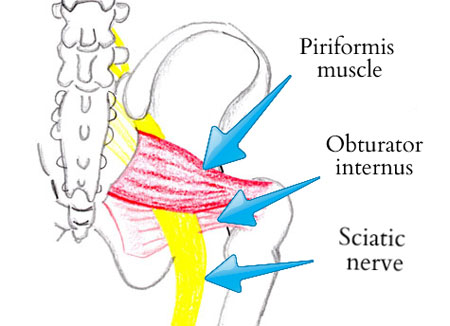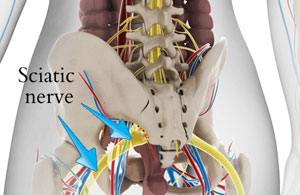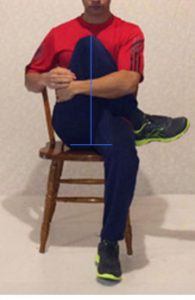Piriformis Syndrome Pain Help
Sherwin Nicholson | Updated May 6, 2020

This muscle often gives us discomfort when it becomes too tight
Are you getting a severe, deep pain in the butt? Does it travel down your leg from time to time? What about when you sit? Does it get worse?
This muscle may very well be to blame.
It is that small muscle located in the region deep within both sides of the hips. It travels and attaches down the back of the pelvis to the top of your femur.
Its purpose is to externally rotate the femur, extend the hip slightly and to abduct the hip. This is when the hip is flexed.
Basically, the piriformis helps you to keep your hips stable while you are standing or walking. It is a flat muscle with a pyramidal shape.
Your Sciatic nerve becomes irritated
When your piriformis gets overused or irritated, it affects the sciatic nerve and causes the pain that you feel. Any swelling or inflammation of the muscle puts pressure on the nerve causing you a lot of discomfort.
If you have inactive glute muscles, usually from sitting too much and little routine hip exercise, you are bound to experience symptoms.
Irritation can also happen from over activity
Too much use can make the hip flexor muscles tighter and shorter causes them to compress the nerve. This is common among athletes who train their gluteus muscles frequently.
The sciatic nerve is located directly underneath the piriformis muscle and is covered by it. This nerve is very thick and long. It originates as 5-6 separate nerves and combines to form one large nerve which runs from the base of the lumbar spine, underneath the muscle and out down to the back of the thighs and feet.
For some people, this nerve is more susceptible to irritability than usual because it travels through the muscle itself rather than underneath it.
Piriformis Syndrome Symptoms
- soreness
- tightness
- aching sensation
- tingling sensation
- weakness or numbness
- irritable sensation from the buttocks, down along the legs
- worsening symptoms with extended sitting
- it hurts when running or walking
- tenderness when pressure (palpation) is applied to the buttock
- aggravated from keeping a wallet in the rear pocket of your pants
- pain after intense physical exercise while in a seated position
It is NOT sciatica
It is similar to sciatica in the respect that it can produce the same symptoms. The difference is the cause of the nerve compression and the location.
Both causes can produce the same symptoms such as discomfort or numbness radiating

The sciatic nerve is large and often gives us discomfort because of this syndrome
down to the rear of the thigh. Both affect the motor function of the foot also.
This difference in the origin of the cause of compression determines the method used to detect this painful condition and also the treatment required to improve your symptoms.
This syndrome can be difficult to diagnose and treat. It frequently is overlooked or misdiagnosed in clinical settings.
Other conditions such as ‘deep buttock’ syndrome which involves gluteus medius, buttock, leg and hamstring pain contribute to some of the confusion with an adequate diagnosis.
Genuine sciatica is often misdiagnosed as this muscular syndrome. As much as 6% of patients who are diagnosed as having lower back pain actually have this condition instead.
Obturator internus muscle irritation
Another muscle that travels in a similar path as the piriformis is known as the obturator internus. This muscle can also become tight, weak and irritated..
When inflamed and tight, it will also put pressure on the sciatic nerve mimicking very similar symptoms. Treatment for problems from the obturator internus can benefit the piriformis and vice-versa.
Without timely diagnosis, the condition of the muscle, sciatic nerve and the muscle that the nerve feeds can worsen. Treatment can become more difficult or less effective as a result of this delay.
The most common age for symptoms to appears is in the early 40’s and 50’s. Women are affected more than men. This syndrome does not correlate to any particular occupation or level of fitness as it can affect anyone.
As much as one-third of people suffer from back issues also have complications that involve pain from the piriformis muscle on the sciatic nerve.
Treatment Options
Exercise has not only been a proven method of treatment but is a necessary one. Strengthening and stretching are vital tools for improving and treating symptoms.
When the piriformis muscle becomes stronger from exercise, it is much less likely to become injured and inflamed. It is also less likely to put pressure on the nerve by lengthening it from specific stretching techniques.
It is exercise from specific strengthening and stretching techniques that are necessary for treating this syndrome. Exercise that is intense while seated only serves to aggravate this condition. This applies especially to seated exercises such as rowing and cycling. Repetitive activities cause overuse injuries to the sciatic nerve and piriformis muscle.
In addition to exercise, ice, rest, muscle relaxants and anti-inflammatory medication also provide significant but temporary relief. Soft tissue mobilization, mobilizing the hip joint, specific stretches and movements, strengthening of the glutes can improve this syndrome dramatically.
the hip joint, specific stretches and movements, strengthening of the glutes can improve this syndrome dramatically. All of these techniques are available in detail through many targeted exercises that condition these muscle groups.
These varied and selected exercises each specifically strengthen and stretch the piriformis, obturator internus, and glutes effectively to alleviate the syndrome, sciatica, lower back and hip pain.
Do This Stretch for a world of difference
Do this stretch for glute muscle discomfort. It will help to alleviate both piriformis and sciatic discomfort if done slowly and consistently. It will take time for you to get comfortable with this move and it shouldn’t be easy to do either. After all, your piriformis hasn’t been exercised for a long time. So be patient and persistent.
It is easy to do and can be done anywhere while seated. If done well, you will begin to feel a strong stretch sensation directly from the deeper and higher part of your butt muscles just in behind the rear of your hip.
This will take several minutes to perform because during the first minute of your stretch, you will initially feel resistance.
If you simply maintain this hold for at least 1-2 minutes, then the muscle will no longer resist and you will begin to experience an actual stretch. The more that you can follow this practice, you will be better able to condition your leg muscle to relax into the stretch sooner.
This means you’ll experience a more efficient stretch and will be able to relieve your pain sooner.
For more help:
Downloadable help for Piriformis syndrome
References:
- www.backcarecanada.ca
- Management of chronic lbp.Bogduk N1.-http://www.ncbi.nlm.nih.gov/pubmedhealth/PMH0004665/
- Persistent back pain and sciatica in the United States: patient characteristics. – Long DM1, BenDebba M, Torgerson WS, Boyd RJ, Dawson EG, Hardy RW, Robertson JT, Sypert GW, Watts C. J Spinal Disord. 1996 Feb;9(1):40-58. Author information

